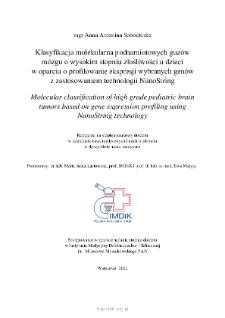- Search in all Repository
- Literature and maps
- Archeology
- Mills database
- Natural sciences
Advanced search
Advanced search
Advanced search
Advanced search
Advanced search

Object
Title: Molecular classification of high grade pediatric brain tumors based on gene expression profiling using NanoString technology
Contributor:
Łastowska, Maria Anna (Promotor) ; Matyja, Ewa (Promotor)
Place of publishing:
Description:
Bibliografia zawiera 95 pozycji ; 97 s.: ryc., tabl.; 30 cm.
Degree name:
Level of degree:
Degree discipline :
Degree grantor:
Instytut Medycyny Doświadczalnej i Klinicznej im. M. Mossakowskiego PAN
Abstract:
Brain tumors in children are the second most common group of tumors after the leukemias. They represent 20-25% of all pediatric tumors and are still a leading cause of death in this age group. Central nervous system tumors in children can occur in all anatomical localization, although the most common is the posterior fossa region. The main therapeutic problem with tumors localized in the infratentorial region, especially in the case of brainstem tumors with diffuse growth pattern, are limited access totumor site and thus inability to perform complete resection. Routine histopathological analysis is not always an objective prognostic factor, therefore there is a need for more reliable methods that can successfully stratify patients to risk groups, as well as for novel therapeutic approaches for patients that don’t meet the standard criteria for treatment. Until recently, prognostic criteria in brain tumors were based on extension of surgical resection of the tumor and histopathological assessment. In recent years there has been remarkable progress in molecular analysis of brain tumors, which resulted in the actualization of WHO classification in 2021. Genetic and epigenetic profiling of brain tumors had an impact on diagnosis, introducing new molecular subgroups and a novel category of tumors. Nevertheless, most of the molecular biology techniques used in research require a high level quality and integrity of RNA, which is not obtainable in the case of Formalin-Fixed Paraffin-Embedded (FFPE) material, routinely used and available in pathomorphological laboratories. Therefore, this dissertation is focused on an attempt to classify high grade brain tumors in children based on gene expression analysis performed by NanoString technology that allows working with degraded RNA.The main objective of this dissertation was a molecular classification of high grade, infratentorial brain tumors in children. Analyses involved designing and testing of the unique marker gene signatures, specific for molecular types of selected infratentorial tumors, which are characterized by poor prognosis for patients, therefore presenting a great challenge for neuropathologists and pediatric oncologists. Moreover, the further objectives are establishment of biological and clinical correlations in analyzed tumors, comparison of the results to current literature data and an assessment of the utility of nCounter Analysis System for tumor diagnosis. An additional goal was to identify immunohistochemical markers for selected molecular groups of analyzed brain tumors.Results of the dissertation confirm that establishing the unique gene signatures for medulloblastoma, ependymoma, CNS HGNET-BCOR and CNS-HGNET-MN1 tumors, as well as RNA expression profiling of FFPE blocks using the nCounter Analysis System, is an useful technique that allows for identification of molecular groups in pediatric brain tumors. This approach allowed for ependymoma and medulloblastoma molecular group identification and detection of two CNS HGNET-BCOR tumors. After accomplishment of gene expression analysis, biological and clinical correlations were established and the results demonstrated that in ependymoma patients molecular group correlates with clinical features, including rates of survival. The results of immunohistochemical analyses imply that in the case of WNT medulloblastoma, the ALK protein expression may serve as a potential diagnostic marker, whereas, the BCOR protein expression may serve as a surrogate marker for CNS HGNET-BCOR tumors.
Detailed Resource Type:
Format:
Resource Identifier:
Source:
Language:
Language of abstract:
Rights:
Creative Commons Attribution BY 4.0 license
Terms of use:
Copyright-protected material. [CC BY 4.0] May be used within the scope specified in Creative Commons Attribution BY 4.0 license, full text available at: ; -
Digitizing institution:
Mossakowski Medical Research Institute PAS
Original in:
Library of the Mossakowski Medical Research Institute PAS
Projects co-financed by:
Access:
Object collections:
- Digital Repository of Scientific Institutes > Partners' collections > Mossakowski Medical Research Institute PAS > Theses > Ph.D Dissertationes
Last modified:
Jan 10, 2023
In our library since:
Jan 9, 2023
Number of object content downloads / hits:
916
All available object's versions:
https://rcin.org.pl./publication/273569

 INSTYTUT ARCHEOLOGII I ETNOLOGII POLSKIEJ AKADEMII NAUK
INSTYTUT ARCHEOLOGII I ETNOLOGII POLSKIEJ AKADEMII NAUK
 INSTYTUT BADAŃ LITERACKICH POLSKIEJ AKADEMII NAUK
INSTYTUT BADAŃ LITERACKICH POLSKIEJ AKADEMII NAUK
 INSTYTUT BADAWCZY LEŚNICTWA
INSTYTUT BADAWCZY LEŚNICTWA
 INSTYTUT BIOLOGII DOŚWIADCZALNEJ IM. MARCELEGO NENCKIEGO POLSKIEJ AKADEMII NAUK
INSTYTUT BIOLOGII DOŚWIADCZALNEJ IM. MARCELEGO NENCKIEGO POLSKIEJ AKADEMII NAUK
 INSTYTUT BIOLOGII SSAKÓW POLSKIEJ AKADEMII NAUK
INSTYTUT BIOLOGII SSAKÓW POLSKIEJ AKADEMII NAUK
 INSTYTUT CHEMII FIZYCZNEJ PAN
INSTYTUT CHEMII FIZYCZNEJ PAN
 INSTYTUT CHEMII ORGANICZNEJ PAN
INSTYTUT CHEMII ORGANICZNEJ PAN
 INSTYTUT FILOZOFII I SOCJOLOGII PAN
INSTYTUT FILOZOFII I SOCJOLOGII PAN
 INSTYTUT GEOGRAFII I PRZESTRZENNEGO ZAGOSPODAROWANIA PAN
INSTYTUT GEOGRAFII I PRZESTRZENNEGO ZAGOSPODAROWANIA PAN
 INSTYTUT HISTORII im. TADEUSZA MANTEUFFLA POLSKIEJ AKADEMII NAUK
INSTYTUT HISTORII im. TADEUSZA MANTEUFFLA POLSKIEJ AKADEMII NAUK
 INSTYTUT JĘZYKA POLSKIEGO POLSKIEJ AKADEMII NAUK
INSTYTUT JĘZYKA POLSKIEGO POLSKIEJ AKADEMII NAUK
 INSTYTUT MATEMATYCZNY PAN
INSTYTUT MATEMATYCZNY PAN
 INSTYTUT MEDYCYNY DOŚWIADCZALNEJ I KLINICZNEJ IM.MIROSŁAWA MOSSAKOWSKIEGO POLSKIEJ AKADEMII NAUK
INSTYTUT MEDYCYNY DOŚWIADCZALNEJ I KLINICZNEJ IM.MIROSŁAWA MOSSAKOWSKIEGO POLSKIEJ AKADEMII NAUK
 INSTYTUT PODSTAWOWYCH PROBLEMÓW TECHNIKI PAN
INSTYTUT PODSTAWOWYCH PROBLEMÓW TECHNIKI PAN
 INSTYTUT SLAWISTYKI PAN
INSTYTUT SLAWISTYKI PAN
 SIEĆ BADAWCZA ŁUKASIEWICZ - INSTYTUT TECHNOLOGII MATERIAŁÓW ELEKTRONICZNYCH
SIEĆ BADAWCZA ŁUKASIEWICZ - INSTYTUT TECHNOLOGII MATERIAŁÓW ELEKTRONICZNYCH
 MUZEUM I INSTYTUT ZOOLOGII POLSKIEJ AKADEMII NAUK
MUZEUM I INSTYTUT ZOOLOGII POLSKIEJ AKADEMII NAUK
 INSTYTUT BADAŃ SYSTEMOWYCH PAN
INSTYTUT BADAŃ SYSTEMOWYCH PAN
 INSTYTUT BOTANIKI IM. WŁADYSŁAWA SZAFERA POLSKIEJ AKADEMII NAUK
INSTYTUT BOTANIKI IM. WŁADYSŁAWA SZAFERA POLSKIEJ AKADEMII NAUK




































